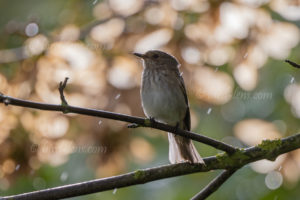 At first glance, Spotted Flycatcher (Muscicapa striata) may look dull mouse-gray-brown and a bit boring. The light pink eye ring at least is often striking in the field. In this photo in a light late summer rain, the little colored eye-ring and the pink to horn-colored base of the lower beak, can be clearly seen.
At first glance, Spotted Flycatcher (Muscicapa striata) may look dull mouse-gray-brown and a bit boring. The light pink eye ring at least is often striking in the field. In this photo in a light late summer rain, the little colored eye-ring and the pink to horn-colored base of the lower beak, can be clearly seen.
The matt white underside and especially the noticeable light gray stripes on the chest are nice to see. The color is immediately reminiscent of that of the secretly living Song Thrush (Turdus philomelos). But the Song Thrush looks more bulky and is more powerful.
As inconspicuous as the Spotted Flycatcher look, it is surely better to consider them beautiful in a humble way. The flight of prey is always impressive. If you watch them for a short time you will be amazed by their repid fly-catching flights. Spotted Flycatchers fly from a high perch, fly outside to grab a flying insect, and usually return to the same spot. Flying insects such as moths, butterflies (Lepidoptera), damselflies (Tipulidae), mosquitoes (Nematocera) and other flying insect orders are the preferred prey. In bad weather, they can search trees and bushes for other insect food as well.
When it rains, Spotted Flycatchers can also be observed resting for some time in a slightly covered area. This was the case on Heligoland in September 2020. A migratory bird from the far north rests here in a summer rain below the famous red sandstone cliffs. The background is nicely shaped by some brown seed pods from the bushes behind. This gives the picture a special touch in the backlight.
The place where this Spotted Flycatcher was photographed is a popular approach point in the north of the island. After many, many kilometers of migration across the open sea, the migratory birds find their first refuge here on dry land.
In order to cope with the growing demand for top pictures of the rarer species of the Palearctic, Bird-lens.com endeavors to further expand the range of images of birds in the Western Palearctic. Trips to nearby and remote locations to snap pictures of rare birds of the Western Palearctic have been very successful. This picture of the blog is only a first impression, which you can find very soon in the gallery in the “Picture Shop“. Just leave a message if bird-lens.com can serve with an image.